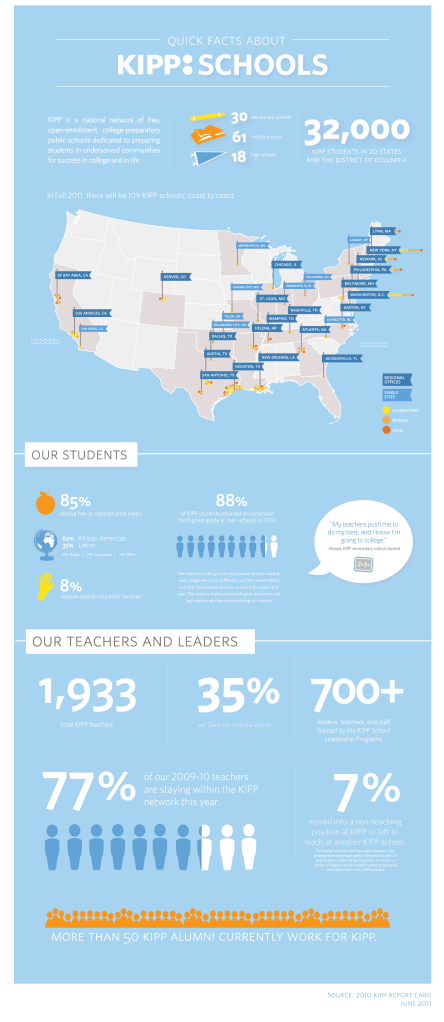KIPP
The Story of KIPP from KIPP Foundation on Vimeo.
KIPP Schools
KIPP, the Knowledge Is Power Program, is a national network of free, open-enrollment, college-preparatory public schools with a track record of preparing students in underserved communities for success in college and in life. There are currently 109 KIPP schools in 20 states and the District of Columbia serving more than 32,000 students.
The story of KIPP is tremendously inspiring. It is the powerful story of two teachers, Mike Feinberg and Dave Levin, who launched in 1994 a fifth-grade public school program in inner-city Houston, TX, after completing their commitment to Teach For America. Following that small start, Feinberg remained in Houston to lead KIPP Academy Middle School, while Levin returned home to New York City to establish KIPP Academy in the South Bronx. Since then, KIPP schools have expanded and achieved unprecedented success throughout the United States, serving in2011 more than 27,000 students in 20 states and the District of Columbia.
While fewer than 40% of students in low-income families attend college nationally, more than 85% of KIPP students who complete 8th grade have gone on to college. This rate, more than doubling the national average, is staggering.
This success, in turn, has led to a great number of accolades, including The $100,000 Charles Bronfman Prize in 2009 to Mike Feinberg and Dave Levin.
KIPP, though, has its detractors. Some point to an attrition rate reportedly as high as 60%. Others say that KIPP’s rigorous admission standards – with as many as 10 times more applicants than places in some schools – enable the schools to attract and admit students and families who would succeed anyway.
In particular, it is clear that KIPP schools have not demonstrated an ability to engender success among IEP students diagnosed with conduct disorders, serious emotional disturbances, or other such learning disabilities, because students bearing such issues do not survive the difficult and highly competitive admissions process.
Finally, another group of critics say that KIPP schools are successful only because they spend more money per student. The schools certainly are able to spend more, because they have become well-funded through private donations supplementing their government grants.
Still KIPP Schools are the subject of great accolades. This report on ABC World News in 2007 is dramatic in its portrayal of the special qualities of the KIPP Schools.
To me, the most apparent feature of KIPP Schools is that they have been able to change the spirit and attitude of both students and teachers. it is not just the increase in class time, or the increase in homework, or class sizes. It is really a completely different culture, one in which working much harder, putting more time into understanding and improving performance in academics – especially math, and being “smart” is very cool.
It is difficult for me to deny that KIPP schools have been successful at something. There is little doubt that its students have been achieving success that is unprecedented in their families and communities. Or, that these children are exceeding even their own initial expectations.
The schools may, in fact, be selectively neglecting the majority of students. Nor are the kinds of investments of financial and human capital sustainable. But the result are impressive.
Much has been written about the success of KIPP and the schools have won them many notable fans, including Bill Gates. He refers to KIPP as being one of the places in which good teaching is rewarded. Here is Gates speaking about this in 2009 at a TED talk:
Five Pillars
KIPP Schools share a core set of principles, which they call the Five Pillars. These are:
- High Expectations
- Choice & Commitment
- More Time
- Power to Lead
- Focus on Results
Ultimately, I believe that it is these that have the effect of changing the culture of the KIPP community. Certainly there are different ways of valuing results, both for students and the teaching staff. And when kids are in school for up to 8 hours a day and are given 2-4 hours of homework, some things are sacrificed. But these sorts of issues, I think are those that many people are willing to make, if they lead to greater opportunities in school, work, and life.


